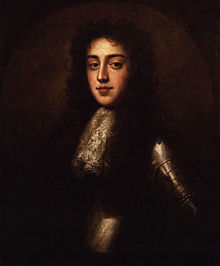John Cutts, 1st Baron Cutts
| The Lord Cutts | |
|---|---|

Lord Cutts
|
|
| Born | 1661 |
| Died | 25 January 1707 |
| Allegiance |
|
| Service/branch | British Army |
| Rank | Lieutenant-General |
| Commands held | Ireland |
| Battles/wars |
Williamite War in Ireland Nine Years' War War of the Spanish Succession |
Lieutenant-General John Cutts, 1st Baron Cutts PC (Ire) (1661 – 25 January 1707), British soldier and author, came from an Essex family.
After a short university career at Catharine Hall, Cambridge, he inherited the family estates, but showed a distinct preference for the life of court and camp. The double ambition for military and literary fame inspired his first work, which appeared in 1685 under the name La Muse de cavalier, or An Apology for such Gentlemen as make Poetry their Diversion not their Business. The next year saw Cutts serving as a volunteer under the Duke of Lorraine in Hungary, and it is said that he was the first to plant the imperial standard on the walls at the storming of Buda (July 1686). In 1687 he published a book of Poetical Exercises, and the following year he was serving as lieutenant-colonel in Holland. General Hugh Mackay described Cutts about this time as pretty tall, lusty and well shaped, an agreeable companion with abundance of wit, affable and familiar, but too much seized with vanity and self-conceit.
Lieutenant-Colonel Cutts was one of William III's companions in the English Revolution of 1688, and in 1690 he went in command of a regiment of foot in Ireland, where he served with distinction. He served with distinction at the Battle of the Boyne, and at the siege of Limerick (1690) (where he was wounded), and King William created him Baron Cutts, of Gowran, in the Peerage of Ireland on 12 December 1690. In 1691 he succeeded to the command of the brigade of the prince of Hesse (wounded at Aughrim), and on the surrender of Limerick was appointed commandant of the town. Next year he served again in Flanders as a brigadier, his brigade of Mackay's division being one of those almost destroyed at Steinkirk. At this battle Cutts himself was wounded. For some time after this, Lord Cutts was lieutenant-governor of the Isle of Wight, but he returned to active service in 1694, holding a command in the disastrous Brest expedition. He was one of Carmarthen's companions in the daring reconnaissance of Camaret Bay, and was soon afterwards again wounded.
...
Wikipedia
